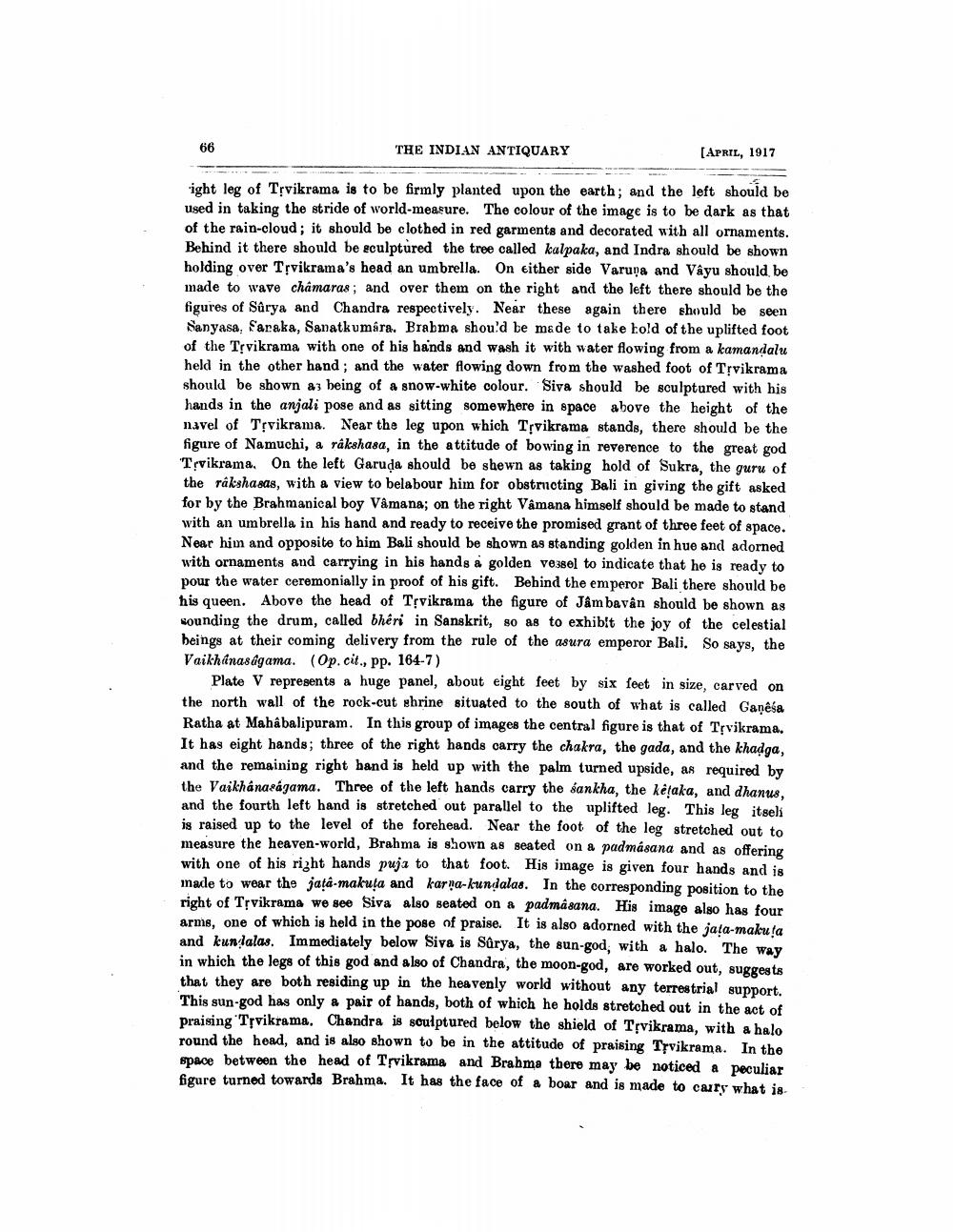________________
66
THE INDIAN ANTIQUARY
[APRIL, 1917
-ight leg of Trvikrama is to be firmly planted upon the earth; and the left should be used in taking the stride of world-measure. The colour of the image is to be dark as that of the rain-cloud; it should be clothed in red garments and decorated with all ornaments. Behind it there should be sculptured the tree called kalpaka, and Indra should be shown holding over Tsvikrama's head an umbrella. On either side Varuņa and Vayu should be made to wave châmaras; and over them on the right and the left there should be the figures of Sûrya and Chandra respectively. Near these again there should be seen Sanyasa, Saraka, Sanatkumara. Brabma should be made to take told of the uplifted foot of the Trvikrama with one of his hands and wash it with water flowing from a kamandalu held in the other hand, and the water flowing down from the washed foot of Trvikrama should be shown as being of a snow-white colour. Siva should be sculptured with his hands in the anjali pose and as sitting somewhere in space above the height of the nuvel of Tevikrama. Near the leg upon which Trvikrama stands, there should be the figure of Namuchi, a rákshasa, in the attitude of bowing in reverence to the great god Trvikrama. On the left Garuda should be shewn as taking hold of Sukra, the guru of the rakshasas, with a view to belabour him for obstructing Bali in giving the gift asked for by the Brahmanical boy Vamana; on the right Vamana himself should be made to stand with an umbrella in his hand and ready to receive the promised grant of three feet of space. Near him and opposite to him Bali should be shown as standing golden in hue and adorned with ornaments and carrying in his hands a golden vessel to indicate that he is ready to pour the water ceremonially in proof of his gift. Behind the emperor Bali there should be his queen. Above the head of Tịvikrama the figure of J&m bavân should be shown as sounding the drum, called bhéri in Sanskrit, so as to exhibit the joy of the celestial beings at their coming delivery from the rule of the asura emperor Bali. So says, the Vaikhanas agama. (Op.cit., pp. 164-7)
Plate V represents a huge panel, about eight feet by six feet in size, carved on the north wall of the rock-cut shrine situated to the south of what is called Ganesa Ratha at Mahabalipuram. In this group of images the central figure is that of Tyvikrama. It has eight hands; three of the right hands carry the chakra, the gada, and the khadga, and the remaining right hand is held up with the palm turned upside, as required by the Vaikhanacagama. Three of the left hands carry the sankha, the kesaka, and dhanus. and the fourth left hand is stretched out parallel to the uplifted leg. This leg itsel is raised up to the level of the forehead. Near the foot of the leg stretched out to measure the heaven-world, Brahma is shown as seated on a padmasana and as offering with one of his right hands puja to that foot. His image is given four hands and is maule to wear the jata makuta and karna-kundalas. In the corresponding position to the right of Trvikrama we see Siva also seated on a padmasana. His image also has four arme, one of which is held in the pose of praise. It is also adorned with the jata-makuta and kun lalas. Immediately below Siva is Sûrya, the sun-god, with a halo. The way in which the legs of this god and also of Chandra, the moon-god, are worked out, suggests that they are both residing up in the heavenly world without any terrestrial support. This sun-god has only a pair of hands, both of which he holds stretched out in the act of Draising Trvikrama. Chandra is soulptured below the shield of Trvikrama, with a halo round the head, and is also shown to be in the attitude of praising Tyvikrama. In the space between the head of Trvikrama and Brahma there may be noticed a peculiar figure turned towards Brahma. It has the face of a boar and is made to carry what is




